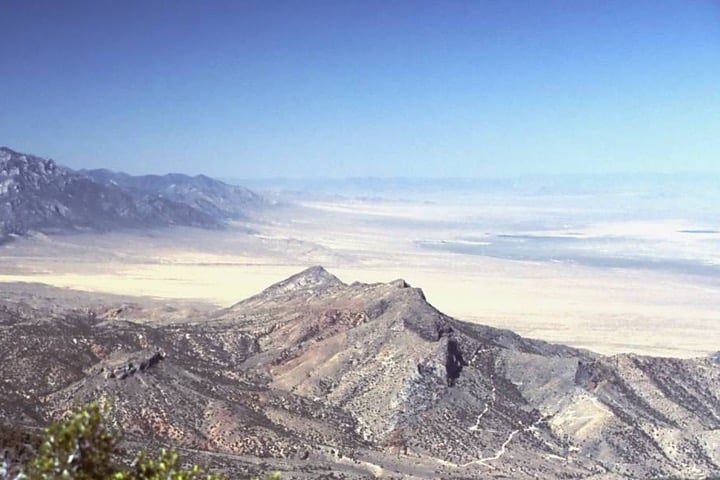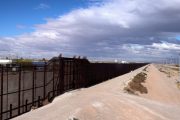
The Railroad Valley playa (RRV) in Nevada is fast becoming ground zero in a fight between mining companies and NASA over the large, flat, undisturbed, mineral-rich lakebed. The lakebed holds vast amounts of lithium, the much-desired green-energy metal needed to produce batteries for electric vehicles (EVs), but also is used by NASA for post-launch satellite calibration.
According to a 2018 presentation by the Jet Propulsion Laboratory at the California Institute of Technology, the “RRV is well characterized and instrumented and its surface is ideal for quantitative calibration traceable to international standards,” and is the “only site in the U.S. that is homogeneous over a large enough area to accommodate large-footprint sensors” for cross-calibration of a number of sensitive satellites. Many of the satellites are used to measure effects of climate change.
Most of the RRV is on public land, managed by the Bureau of Land Management (BLM) which monitors and coordinates the use of the land, including exploration and mining. The Mining Law of 1872 “declared all valuable mineral deposits in land belonging to the United States to be free and open to exploration and purchase.” However, with recent claims by a number of mining companies searching for lithium, the threat to keeping the surface undisturbed has become a major concern for NASA.
With the mining claims threatening to disrupt the surface of the RRV, rendering it useless for vicarious calibration, the Bureau of Land Management filed notice in the Federal Register in April. They noted the withdrawal of over 23,000 acres of public land in the RRV for the next 20 years “to maintain the physical integrity of the surface and subsurface environment to ensure NASA satellite calibration activities are not invalidated or otherwise adversely affected.”
The irony of NASA’s request to preserve the RRV lakebed surface is apparent to all, as the lithium under the surface is key to making EV batteries in the fight to reduce greenhouse gases. That same surface, if left undisturbed, will continue to be used in monitoring Earth’s supposedly warming atmosphere.
As AP News reported, Mark Moneza of Planet Labs, a San Francisco-based satellite imaging company that has relied on NASA’s site to calibrate more than 250 of its satellites since 2016, stated, “As our nation becomes ever more impacted by an evolving and changing environment, it is critical to have reliable and accurate data and imagery of our planet.”
Earlier this month, Congressman Mark Amodei (R-Nev.) introduced legislation to reverse the Department of the Interior’s recent withdrawal of the RRV Bureau of Land Management-controlled land.
In a press release, Amodei stated:
Railroad Valley is home to an abundance of critical minerals that can help boost the American economy, strengthen domestic supply chains, and reduce our dependence on foreign adversaries. That’s why it was especially disappointing that the Administration opted to close the door on this mineral development by approving NASA’s unreasonable demand for exclusive control over the playa in Railroad Valley — even though NASA’s mission in the area would not be impacted by these proposed mining projects.
And what about lithium? It is supposedly a goal of the Biden Administration to boost the development of renewable energy technology and reduce carbon in our atmosphere, yet they support blocking a project to develop the lithium necessary for their clean energy objectives…. This is a prime example of this Administration saying one thing and then doing the exact opposite.
Kevin Moore, chairman and chief financial officer of 3 Proton Lithium, Inc. (3PL), a Carson City-based company that holds numerous mining claims in the RRV, testified recently to a House subcommittee regarding withdrawal of the RRV land. Moore told the committee about the minerals, the extraction process, and the fact that the mining operation would use a “fraction of 1%” of the RRV land.
Moore stated that “the lack of responsiveness and transparency from NASA and other officials in Washington throughout the withdrawal process has been problematic and has resulted in what we feel are uninformed and incorrect assumptions and conclusions about our project.” He shared that the “strategic importance of proceeding with the full development” of the RRV project could not be overstated, “especially as it relates to unshackling the United States from its dependence and over reliance on foreign nations … to supply certain mineral commodities that are vital to the country’s economic and national security.”
He continued, “The Railroad Valley project is a vital part of transitioning to a green economy, creating good-paying American jobs, combatting climate change, ending America’s overreliance on foreign adversaries and securing a domestic supply chain for critical and rare earth minerals.”
However, NASA is holding firm on their position. AP News shared:
“Activities that stand to disrupt the surface integrity of Railroad Valley would risk making the site unusable,” Jeremy Eggers, a spokesman for NASA’s Goddard Space Flight Center in Greenbelt, Maryland, told The Associated Press.
“The ultimate decision was to protect Railroad Valley, which in turn protects the critical scientific data that multiple economic sectors rely on.”
The battle over the RRV is far from over.




